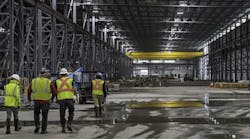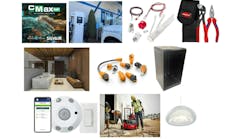While there are some new and improved truck models making their debut in 2009, it will be a quiet year as medium- and heavy-duty truck makers prepare for the last round of changes to diesel exhaust emission standards to go into effect in 2010. One big trend, however, that is picking up steam is demand for hybrid and alternatively fueled trucks.
According to the editors at Electrical Wholesaling's sister publication Fleet Owner, a trade magazine geared toward executives and managers of commercial trucking fleets that operate five or more vehicles, changes among the OEMs themselves may represent the biggest news of the 2009 model year. A deal Navistar forged with General Motors to buy GM's medium-duty truck business fell through, while Caterpillar announced it would no longer make heavy-duty diesel truck engines after 2010 — and promptly announced an alliance with Navistar that will allow both companies to expand their presence in the medium-duty market. Starting next year, Mack Trucks announced that much of its headquarters would shift south to Greensboro, N.C., to be more closely aligned with its sister company Volvo Trucks North America, leaving only engineering and research functions in its Allentown, Pa., location. The move follows a similar shift by Freightliner LLC from its Portland, Ore., headquarters to South Carolina in 2008.
Demand for diesel-electric hybrid medium-duty trucks continues to grow, with OEMs such as Navistar, Kenworth, Peterbilt, and Freightliner increasing production. More interest is being expressed in natural gas-powered trucks too, with step-van maker Freightliner Custom Chassis Corp. seeing a spike in orders in 2008. Yet Fleet Owner Senior Editor Sean Kilcarr predicts that a bigger surge of changes for Class 4 to 8 commercial vehicles should re-emerge in 2010, as OEMs adjust their chassis in order to accommodate new emission-reduction technology, which for most will be selective catalytic reduction (SCR) systems that spray a urea solution into the tailpipe to substantially reduce oxides of nitrogen (NOx) levels. That doesn't mean OEMs are standing still in 2009 — especially on the lighter side of the ledger, where some retooled Class 1 to 2 commercial models, such as Ford Motor Co.'s Transit Connect van, are making their first appearance in North America. Following is a preview of 2009's light- and medium-duty models.
Dodge
After a spate of new offerings last year, the Dodge Ram 3500, 4500 and 5500 chassis cab medium-duty trucks won't undergo much change for 2009.
The 4500 and 5500 chassis cabs feature one of the largest standard fuel tanks in the segment (52 gal) and feature increased power takeoff (PTO) pump ratings — a 55% increase in gallons per minute to provide more power for pumps, lifts and hydraulic use.
The 4500 and 5500 feature gross vehicle weight ratings topping out at 14,000 lbs and 19,500 lbs, respectively.
Other new product features include a Cummins 6.7L diesel engine option (automatic transmission only) that will now be available with remote start. Both are offered in dual-rear-wheel models and four cab-axle lengths (60, 84, 108, and 120 in.), in 432, 434, dual-rear-wheel, regular, and quad cab configurations.
A 6-speed automatic transmission with PTO is available for these models, along with a 6-speed manual transmission, also featuring PTO capability. An available electronic-shift transfer case is offered, as is a factory-installed exhaust brake.
Bringing even more “big rig” feel, commercial capability and enhanced safety, the brake system on the 3500 chassis cab is upgraded with larger rotors and calipers and thicker brake pads, while its standard GCWR has been increased to 24,000 lbs.
The 3500's all-new brakes are upsized to provide more stopping power, increased brake-pad life and improved fuel economy.
To improve stopping power, front and rear rotor sizes are increased 2% to 360 mm on the front and 358 mm for the rear. In addition, front calipers are upsized 7% to include large, twin 60-mm pistons for maximum stopping power. New brake pads are 14% thicker (12.5 mm) with a 36% larger surface area (99 sq cm). The 3500's new brakes also help reduce brake drag, which results in a fuel economy improvement of 0.5 mpg, says the OEM.
Dodge Ram 3500s also feature a new 5.7L next-generation Hemi V8 with variable valve timing (VVT) that will appeal to fleets requiring a gas engine. The new engine incorporates a 9% higher compression ratio (10.5-to-1) and an active intake manifold. These technologies, combined with engine and powertrain integration improvements, result in a 4% improvement in fuel economy. Preliminary results also show peak torque increases 8% to 404 lb-ft and peak power increases 15% to 380 hp. At 2,000 rpm, torque improves 6% to 350 lb-ft.
www.dodge.com
Ford
Few changes are going to be made to the F-Series Super Duty for 2009, as Ford completely revamped its medium-duty lineup last year. The F-Series Super Duty still features a new 6.4L, power stroke V8 turbocharged diesel engine built by Navistar with a beefed up towing capacity of 24,000 lbs and maximum payload of more than 6,000 lbs.
The F-450 model now incorporates a rear leaf-spring suspension while using the radius arm front suspension. This setup provides for the tightest turning radius in its class, greatly improving maneuverability when towing. The engine delivers 350 hp at 3,000 rpm and 650 lb-ft of torque (on the F-250 and F-350) starting at 2,000 rpm. Transmission choices include a 6-speed manual with overdrive or a TorqShift 5-speed automatic. On the gasoline side, a 5.4L, 3-valve SOHC Triton V8 gas engine is offered with 6-speed manual transmission.
Ford is making some updates to its E-Series line of medium-duty vans for 2009, including a redesigned instrument panel and console, door trim panels with more storage, built-in auxiliary switches users can customize, wider-opening rear doors, and more comfortable seats. The center console doubles the usable storage space of the previous version — and now includes three larger cup holders.
Four new optional user-defined switches on the dashboard are also included as well as a more efficient wiring harness, which makes it easier for upfitters to integrate aftermarket features.
A message center is available in E-Series vans and wagons that feature standard vehicle maintenance information and miles-to-empty and fuel economy numbers.
The message center is standard on vans equipped with the 6.0L, power stroke V8 turbodiesel engine and includes an engine-hour meter that keeps a running total of engine use.
The company is rolling out a new package of products called Ford Work Solutions for its F-Series Super Duty XL, XLT, FX4, and E-Series trucks — a collection of technologies aimed at making business and fleet owners more productive and successful.
Ford Work Solutions include an in-dash computer developed with Magneti Marelli and powered by Microsoft Auto that provides high-speed Internet access via the Sprint Mobile Broadband Network and navigation by Garmin; Tool Link, a radio-frequency identification (RFID) asset tracking system developed with Dewalt and ThingMagic to maintain a detailed real-time inventory of tools or equipment stored in the vehicle; Crew Chief, a fleet telematics and diagnostics system; and a cable lock security system developed in partnership with Master Lock. The chassis and suspension improvements have also resulted in an increase in the maximum GVWR from 14,050 lb to 14,500 lb. Additionally, the maximum front GAWR is increased by about 10%, from 4,600 lbs to 5,000 lbs.
www.ford.com
Freightliner
Freightliner Trucks' newest medium-duty Business Class model is the M2e Hybrid drop-frame truck. It was engineered specifically to deliver fuel savings and reduced emissions in beverage fleets, according to the OEM, which says the truck is also suitable for utility, P&D, and power-takeoff (PTO) applications. The Class 6 truck is powered with the Eaton medium-duty hybrid diesel-electric system.
Freightliner's hybrid electric vehicle (HEV) design, which features a diesel engine coupled with an electric motor/generator and batteries, works in line with the engine and transmission, enabling operation with electric or diesel power either separately or together. According to the company, the M2 106 boasts up to a 30% savings in fuel consumption and up to an 87% reduction in idling time.
Suitable for easy access to cargo and featuring simplified loading and unloading, the drop-frame truck maximizes load capacity while maintaining superior maneuverability, visibility and driver comfort, says the OEM. Like all M2 models, the truck has an aerodynamic aluminum cab and offers a 55° wheel cut, sloped hood and a 2,500-sq-in. windshield for enhanced visibility and increased safety. Freightliner Trucks has not as yet made any other major product announcements for its medium-duty models.
www.freightlinertrucks.com
General Motors
The big medium-duty product news this year is the rollout of the 4500 model cutaway version of the GMC Savana and Chevrolet Express commercial vans. These Class 4 trucks are supported by a stronger chassis that enables a 14,200-lbs GVW with lower mass — giving them a “best-in-class” payload rating of 9,100 lbs, according to GM. The company claims it is the only OEM to offer an emissions-compliant V8 diesel in this GVW category.
The Express/Savana 4500 is offered with a gas V8 and GM's 6.6L Duramax turbodiesel V8. A Hydra-Matic HD 4L85E electronically controlled 4-speed automatic transmission backs both available engines. It was designed for the heavy-duty use of commercial cutaway vans and features a brazed torque converter turbine, induction-hardened turbine shaft, 5-pinion reaction and output gear carriers and improved overrun roller clutch. With a new, strong frame and robust powertrains, the 4500 offers up to 20,000-lb GCWR for exceptional towing capability, says GM. Each model comes with a 5-year/100,000-mile limited powertrain warranty.
Unique frame enhancements, chassis-design details, and drivetrain features deliver flexibility in a single platform, according to the OEM, while the 4500's body structure is designed to handle the extreme duty cycle encountered by many cutaway vehicles. Key features include a new rear axle with reinforced housing, gears and axle tubes, a high-capacity rear spring assembly, rear stabilizer bar, and an enhanced parking brake system with thicker rear brake rotors for improved heat dissipation.
Any 4500 chassis (except school bus applications) specified with the 14,200-lb GVWR and Duramax diesel engine receives a 57-gal rear-mounted fuel tank that was designed with input from upfitters. The tank is mounted lower on the chassis, providing a flat mounting position for ambulance bodies, etc. The tank's fuel sender and all fuel lines have been upgraded to meet B5 biodiesel performance requirements. All other General Motors medium-duty models are expected to continue unchanged into the new model year. These are the conventional Chevy Kodiak and GMC TopKick as well as the Chevrolet and GMC T-Series and W-Series cabovers.
www.gm.com
Isuzu
Navistar's purchase of General Motors' medium-duty business is going to change how Isuzu approaches the U.S. medium-duty market, but this shouldn't affect its 2009 product lineup.
Isuzu will still deliver its Class 3-5 trucks badged as the N-Series for Isuzu dealers and the W-Series for GMC and Chevy dealers. Diesel-powered versions of those trucks will still be manufactured in Japan, while gasoline-powered models will continue to be assembled in the United States. Isuzu is also directly distributing its Class 5-7 F-Series to its 200 U.S. Isuzu dealers. GMC/Chevrolet versions of that medium-duty cab remain badged the T-Series for now.
The long-serving N-Series line of LCFs received a big makeover for the 2008 model year, so little will change on the 2009 models.
Horsepower now sits at 205 at 2,400 rpm for the 5.2L overhead cam, 4HK1-TC turbocharged, intercooled diesel engine, with torque getting a similar boost to 441 lb-ft at 1,850 rpm. That engine covers GVW ranges from 12,000 lbs to 19,500 lbs and has a B10 durability rating of 310,000 mi.
An Aisin A465 heavy-duty, 6-speed automatic with double overdrive or 6-speed manual transmission is available with the 5.2L diesel.
Producing 325 hp and 360 lb-ft of torque, a General Motors gasoline Vortec 6.0L V8 uses the Hydra-Matic 4L80 4-speed automatic.
N-Series diesel models include the NPR, NPR HD and NQR in regular or crew cab models, and NRR. The gasoline engine is available on the NPR and NPR HD models.
Available in four different wheelbases, the N-Series can accommodate truck bodies ranging from 10-ft to 20-ft long, and body/payload combinations weighing between 6,829 lbs and 9,411 lbs.
www.isuzucv.com
Kenworth
Kenworth Truck Co. has expanded its medium-duty offerings into the Class 5 arena with the T170 straight truck, which is offered in a 432 configuration with a GVWR of 19,500 lbs. Standard power is provided by a Paccar PX-6 diesel engine rated at 200 hp and 520 lb-ft of torque. Other standard specs include an 8,000-lb front axle, 11,500-lb rear axle, hydraulic brakes and low-frame height chassis with 19.5-in. wheels and tires. The T170 can be specified with a manual or automatic transmission.
Other T170 features include a single-piece steel bumper placed forward of the hood to help reduce impact damage and Metton quarter fenders to add durability and impact resistance. According to Kenworth, halogen projector low-beam headlamps provide up to 30% more light. There is also a 35-gal steel fuel tank, steel battery box and ABS cover, and heat-treated frame rail.
T170 options include a telescoping/tilting steering wheel, workstation with two 12V power ports, corner windows and an electronic shift module. The OEM also points out that because there is no doghouse, noise inside the cab is reduced.
Kenworth has also announced full production of its medium-duty, diesel-electric hybrid models. These Class 6 and 7 trucks feature Paccar PX-6 engines and Eaton's hybrid drive system. According to Kenworth, the fuel economy benefit for these trucks may be as high as 30% in P&D applications and up to 50% in utility truck operations.
The AG210L single-axle rear suspension is described as “an economical choice” for Kenworth Class 6 and Class 7 conventional models. The AG210L, which is a 2-bag version of the heavier AG400L, is a 21,000-lb rear suspension for the T370 and T270.
Continuing in the lineup with no major changes announced are the Class 7 T370, Class 6 T270, and T270 hybrid-electric conventional models, as well as the Class 6 K260 and Class 7 K360 cabovers. The OEM notes the K260 and K360 are based on the LF55 built by its European subsidiary (DAF).
www.kenworth.com
Mitsubishi
According to Mitsubishi Fuso, after introducing significant upgrades for the 2008 model year, the OEM isn't making any significant changes to its lineup of medium-duty trucks.
The light-duty Class 3 FE125 (12,500-lb GVW) has an OBD II emissions monitoring system required by California and other states. Power is provided by a 4.9L Mitsubishi diesel, producing 185 hp and 391 lb-ft peak torque. It will only be available with an Aisin 6-speed automatic transmission. Offered in three wheelbases ranging from 114.6 in. to 153.4 in., the FE125 will accommodate bodies up to 18 ft.
The Class 4 FE145 (14,500-lb GVW) is available in four wheelbases, including a 155.3 in. length introduced for the first time in 2008. An Aisin automatic transmission is standard.
The Class 5 FE180 (17,995 lb GVW), which includes five wheelbases since the 2008 addition of a 189.4-in. version has an available 6-speed Mitsubishi manual transmission.
The Fuso lineup also includes a 434 FE140 (in a 138.2-in. wheelbase) and the FE145 Crew Cab.
The introduction of an aerodynamic cab last year on FK/FM medium-duty models cuts drag up to 25% in flatbed applications and lower chassis heights. Those include the Class 6 FK200 (19,850-lb GVW), which has a frame height of 36 in. and can accommodate bodies up to 24 ft. Like all FK/FM models, it's powered by the 7.5L 6M60 Fuso diesel, producing 243 hp and a peak torque of 513 lbs-ft.
The Class 6 FK260 (25,995-lb GVW) is offered with either a spring or full-air rear suspension with the frame height at 38 in. The air-suspension version can dump its air bags to lower the truck an additional 2.5 in. while stationary. The FK260 includes air brakes.
The Class 7 FM330 (32,900 lb GVW) can be fitted with bodies ranging from 16 ft to 28 ft.
www.mitfuso.com
Sterling
Sterling Truck Corp.'s newest medium-duty model — the Bullet — is a Class 4/-5 chassis-cab truck. The Bullet, a twin of the medium-duty Dodge Ram, features such standard specs as a Cummins 6.7L ISB diesel with exhaust brake, a power take-off prep package, air conditioning, and cruise control. The Bullet is offered with a regular cab (2-door) or quad cab (4-door) with choice of 432 or 434 drivetrain.
The company has made no announcement of changes to its Class 3-6 Sterling 360 low cabover or to models in its Acterra line of Class 5-and-up conventionals. The 360 is offered in three pre-engineered models in popular weights and sizes. Five wheelbases are offered to accommodate a full range of 12-ft to 20-ft bodies.
Sterling has introduced several factory-installed safety options on all Acterras as well as its heavy-duty truck models. These include air disc brakes, a new collision warning system from Eaton and roll stability control (RSC) from MeritorWabco. The OEM says its proprietary air disc brakes are suitable for applications that are notoriously hard on truck brakes.
The OEM is offering the new Eaton-Vorad VS-400 collision-warning system, which includes features such as a cruise control regulating tool, a more compact sensor, and an easier-to-understand driver interface unit. The VS-400 provides in-cab notifications that help the driver identify traffic conditions in advance. Alerts are provided for slow-moving vehicles, stationary objects, and short following distance warnings, says Sterling. This system includes the SmartCruise feature, which uses data from the collision warning system to help the truck maintain the appropriate minimum distance from the vehicle in front of it. All of these notifications are communicated to the driver through an upgraded driver-interface unit that features an LCD screen with text and graphics.
Already available for order is the MeritorWabco RSC, which Sterling calls an “economical, reliable and proven system for avoiding rollover accidents.” The OEM says it is offering RSC for operators who want to reduce rollovers as well as jackknifing and loss of control.
www.sterlingtrucks.com
Workhorse
Recently, the walk-in van manufactured by Workhorse Custom Chassis has seen a number of changes, starting with its heavy-duty (19,500-lb and 23,500-lb GVWR) W62 chassis and continuing with a reworked front hood and grille. The makeover has also brought the truck a new name, the MetroStar. The OEM says the new moniker relates the vehicle to the “Star” model names — WorkStar, DuraStar, etc. — used by International, of which Workhorse is a wholly owned subsidiary.
The MetroStar is available on 86.5-in. and 93.5-in.-wide bodies, offers cargo lengths from 10 ft to 22 ft, and can be ordered built on the full range of Workhorse gas and diesel chassis options, which run from 9,400-lb to 23,500-lb GVWR. The manufacturer uses GM's 4.8, 6.0 and 8.1L Vortec gas engines as well as International's 4.5L MaxxForce 5 V6 diesel. While the MetroStar is offered exclusively through Workhorse dealerships and built exclusively on Workhorse chassis, it can be fitted with Utilimaster and Morgan Olson bodies.
Workhorse is also offering a power take-off (PTO) option for walk-in trucks built on its heavy-duty W62 diesel chassis. The PTO option can be installed at the dealer, the company says, before the truck is upfitted with vocational equipment such as air compressors, generators and hydraulic pumps. Workhorse says it has created an “integrated build process” that enables the PTO option to be specified with the chassis right from the dealer.
www.workhorse.com








